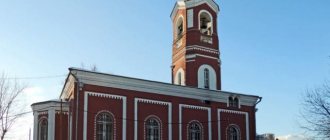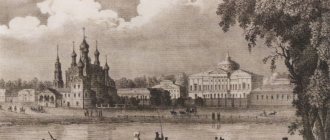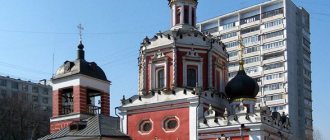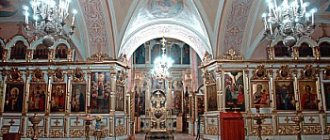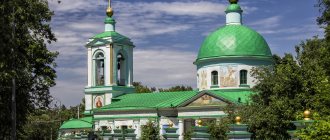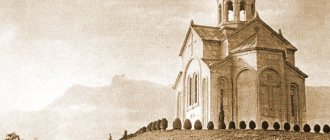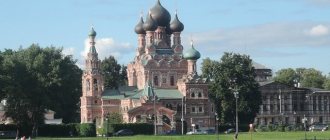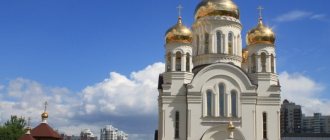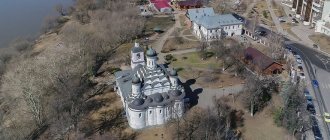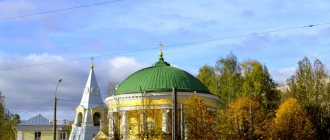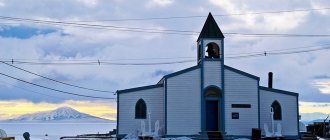"Save me, God!".
Thank you for visiting our website, before you start studying the information, please subscribe to our Orthodox community on Instagram, Lord, Save and Preserve † - https://www.instagram.com/spasi.gospodi/. The community has more than 60,000 subscribers. There are many of us like-minded people and we are growing quickly, we post prayers, sayings of saints, prayer requests, and timely post useful information about holidays and Orthodox events... Subscribe. Guardian Angel to you!
There are quite a large number of different Orthodox churches around the world. The Church of the Life-Giving Trinity in Starye Cheryomushki deserves special attention. It has an extraordinary history. This is an ancient church, inside of which there is real beauty and miraculous holy images. If possible, you should definitely visit it at least once.
Dowry of a young bride
The year 1720 turned out to be a happy year for the hereditary Moscow noblewoman Anna Mikhailovna Pronchishcheva - God sent her a husband, and not just any husband, but a respectable man, a state councilor. As a dowry, her parents gave her a wasteland, located where the houses of the Academichesky district of the capital now stand, and bought in ancient years by her great-grandfather Nikolai Alekseevich.
That’s where the young people settled, building the Troitskoye-Cheryomushki estate. Why Trinity? In honor of the stone church of the same name, erected on its territory next to the spacious manor house. It stood exactly on the spot where today the new Church of the Life-Giving Trinity was built in Starye Cheryomushki.
Subsequent fate of the temple and estate
Subsequently, the estate changed hands many times, but since most of the time it was owned by the family of the Moscow rich man N.P. Andreev, who bought it in 1810, it began to be called Troitskoye-Andreevo.
This first Church of the Life-Giving Trinity in Starye Cheryomushki stood until 1879, but, having fallen into extreme disrepair, was completely rebuilt by the priest Father John (Zabavin). The necessary funds for the work were donated by one of the pious parishioners of the temple, S. N. Tikhonov. The previous building was completely dismantled, and a new one was erected in its place, to which a bell tower made in the neoclassical style was subsequently added.
The temple in Novokosino was built at the numerous requests of local residents
The construction of the temple in Novokosino is a response to requests from residents of eastern Moscow who needed spiritual and moral education.
During Soviet times, a real small city with developed infrastructure grew up in Novokosino. However, in this “city” there were no temples or churches. And old Moscow, rich in its churches, is distant from Novokosino.
On June 22, 1999, Archpriest John Chizhenok received a blessing from the Patriarch of Moscow for the construction of the temple from Patriarch Alexy II of Moscow and All Rus'.
June 22, 1999
on this day, Archpriest John Chizhenok received a blessing for the construction of the temple
Since the temple was built solely on voluntary donations, its construction was continually postponed. Construction of the construction site began only in January 2009.
By April of the same year, the builders had completed the construction of the basement floor, and the construction of the walls began.
On June 3, 2009, Bishop Arseny, the first vicar of His Holiness the Patriarch of Moscow and All Rus' and the head of the Novokosino District Administration Valery Mernenko laid a consecrated capsule at the foundation of the temple.
The capsule contained a commemorative document in which the date of foundation and information about the Patriarch and President of the Russian Federation under whom construction began were written down.
The status of the Patriarchal Metochion is a special church status.
It assumes direct vertical subordination to the Patriarch of Moscow and All Rus'.
This means that the direct management of the metochion is carried out by the Patriarch and all decisions about the life of the temple are made by him. The rector of the temple is the patriarchal vicar.
On November 4, 2009 - on the feast of the Kazan Icon of the Mother of God - the first liturgical prayer service was held in the church with the reading of an akathist to All Saints who have shone in the Russian land.
The church on Suzdalskaya had been completed by that time, and the builders moved on to its improvement. Residents of Novokosino were present at the prayer service.
The first Divine Liturgy in the church was celebrated on the Feast of the Entry of the Lord into Jerusalem, March 28, 2010. After this, services are performed regularly.
His Holiness Patriarch Alexy II. The idea of building a temple in Novokosino belongs to him and the Moscow City Hall
The Novokosinsk Church differs from other churches in that parishioners can pray to all Russian saints there.
Desecration of a shrine
During the period of persecution of the church that followed the Bolsheviks’ rise to power, the Church of the Life-Giving Trinity in Starye Cheryomushki fully shared the fate of most Russian shrines. Until 1935, his community somehow resisted attacks from the organizers of numerous anti-religious campaigns, but the forces turned out to be too unequal. The group of believers could not go against the prevailing state policy for a long time, and as a result, the temple was taken away from them.
The building, which was once built with donations from the pious merchant Tikhonov, was distinguished by its excellent strength, and the new masters of life, having thrown crosses, domes and other symbols alien to their ideology onto the ground, placed an artel producing sports equipment in the desecrated temple.
Cathedral of All Saints who shone in the Russian land
It takes place on the 2nd Sunday after Pentecost, i.e. on the second Sunday after Trinity
history of the holiday
The holiday appeared in the middle of the 16th century, under Metropolitan Macarius. As a result of the patriarch's reforms, Nikon was abandoned. It was restored on August 26, 1918 by the decision of the All-Russian Local Council of 1917-1918, and from 1946 the festive service began to be solemnly celebrated on the 2nd Sunday after Pentecost.
The Saints of the Church are helpers and representatives before God throughout our entire earthly life, therefore frequent appeal to them is a natural need of every Christian. Moreover, when turning to Russian saints, we have even greater boldness, since we believe that “our holy relatives” never forget their descendants, who celebrate “their bright holiday of love.”
“In Russian saints we honor not only the heavenly patrons of holy and sinful Russia: in them we seek revelation of our own spiritual path” and, carefully peering at their exploits, we try to “imitate their faith” so that the Lord will not continue to abandon our land with His grace and would reveal His saints in the Russian Church until the end of the century.
From the emergence of Christianity to the priesthood of Metropolitan Macarius of Moscow (+1563)
| Apostle Andrew the First-Called |
The history of holiness in Rus' begins, undoubtedly, with the preaching of the holy Apostle Andrew the First-Called within the boundaries of our present Fatherland, in the future Azov-Black Sea Rus'. Apostle Andrew converted our direct ancestors, the Sarmatians and Tauro-Scythians, to Christianity, laying the foundation for Churches that did not cease to exist until the Baptism of Rus'. These Churches (Scythian, Kherson, Gothic, Sourozh and others), which were part of the Metropolis of Constantinople (and later the Patriarchate), also had Slavs in their fold. The largest of them was the Kherson Church - the Russian Forefather.
The successor to the work of the Apostle Andrew in Chersonesos was the Hieromartyr Clement, an apostle from the 70s, a disciple of the Apostle Peter, the third Bishop of Rome. Having been exiled there in 94 by Emperor Trajan for converting many noble Romans to Christianity, Saint Clement “found about 2 thousand Christians among the many communities and churches of Crimea as the spiritual heritage of the Apostle Andrew.” In Chersonesos, Saint Clement died a martyr around the year 100 during the persecution of the same Trajan.
| Holy princes and passion-bearers Boris and Gleb |
Almost immediately after the Baptism of Rus', in 988, the newborn Church revealed to the entire Orthodox world its children, who became famous for their godly lives, as a kind of response to the preaching of the Gospel in Rus'. The first saints canonized by the Russian Church were the sons of Prince Vladimir - the passion-bearers Boris and Gleb, who suffered martyrdom from their brother Svyatopolk in 1015. National veneration of them, as if “anticipating church canonization,” began immediately after their murder. Already in 1020, their incorruptible relics were found and transferred from Kyiv to Vyshgorod, where a temple was soon erected in their honor. After the construction of the temple, the head of the Russian Church at that time, the Greek Metropolitan John I, “with a council of clergy in the presence of the Grand Duke (the son of Equal-to-the-Apostles Vladimir - Yaroslav) and in the presence of a large crowd, solemnly consecrated it on July 24, the day of the death of Borisov, and placed in it the relics of the newly-minted miracle workers and established to celebrate this day annually in memory of them together.” Around the same time, around 1020-1021, the same Metropolitan John I wrote a service to the martyrs Boris and Gleb, which became the first hymnographic creation of our Russian church writing.
The second saint solemnly canonized by the Russian Church was the Monk Theodosius of Kiev-Pechersk, who died in 1074. Already in 1091, his relics were found and transferred to the Assumption Church of the Pechersk Monastery - local veneration of the saint began. And in 1108, at the request of the Grand Duke Svyatopolk, his church-wide glorification took place.
However, even before the church glorification of Saints Boris, Gleb and Theodosius in Rus', they especially revered the holy Russian first martyrs Theodore the Varangian and his son John (+ 983), the holy Equal-to-the-Apostles Great Princess
Death of the temple
In 1963, the Church of the Life-Giving Trinity in Starye Cheryomushki was completely destroyed, as it was located on a site that was included within the city limits, and its development was carried out in accordance with the master plan approved by the highest authorities. Based on this document, a swimming pool was built where the temple of God had previously stood, but very soon, according to the testimony of the Muscovites themselves, it turned into a garbage dump.
Used materials
- “Construction of the temple complex”, page of the official parish website:
- “All the saints who shone forth in the Russian land (Stupino)”, page of the official website of the Stupino deanery:
- “Church of All Saints who shone forth in the Russian land”, page of the official website of the Moscow diocese:
- “Stupino. Church of All Saints who shone forth in the Russian land (under construction)” // Website page “People's catalog of Orthodox architecture”:
- h
[1] “Decree No. 2700 of July 11, 2008” // Official website of the Moscow Diocese:
[2] “Decree No. 3281 of September 2, 2011” // Official website of the Moscow Diocese:
The period of spiritual revival of the country
The opportunity to bring the trampled shrine back to life appeared for residents of the area only with the onset of perestroika. In 1997, an initiative group was created that turned to the patriarch personally for support. His Holiness not only supported their endeavor, but also provided practical assistance, blessing the creation of a parish community. Soon after this, a meeting was held, during which the composition of the parish council was approved and its chairman was elected.
The last decade of the last century has become a truly fertile period. The new democratic government radically changed its attitude towards religion, putting a lot of effort into restoring previously destroyed shrines.
A shrine revived from oblivion
Already in March 1999, a place was allocated for future construction. The start of work was preceded by a long period of obtaining permits and creating an architectural project, which was approved in the spring of 2001. It is based on authentic archival materials, thanks to which the current Church of the Life-Giving Trinity in Starye Cheryomushki, photos of which are given in the article, is as close in appearance as possible to what was once destroyed by a decree of the atheistic authorities.
Hundreds of people took part in the restoration work - both professionals and their volunteer assistants. Their work was crowned with a worthy reward - in 2005, on the map of Orthodox Moscow, another one was added to its previous shrines - the Church of the Life-Giving Trinity in Starye Cheryomushki, address: st. Shvernika, 17, building 1, page 1.
Over the past decade, the temple has firmly taken one of the leading places among the spiritual centers of the capital. The organization of its religious life is led by Archpriest Father Nikolai (Karasev), appointed back in 1999, one of those people whose labors revived the Church of the Life-Giving Trinity in Starye Cheryomushki from oblivion.
The schedule of services held there: on weekdays they begin at 8:00 and continue at 17:00. On Sundays and holidays, early mass begins at 7:00, late at 10:00, and evening services at 17:00.
Schedules of services in the Cheryomushki Church
The temple is open daily. On weekdays, Liturgies begin at 8:00 and 17:00. On weekends and holidays, Liturgies are held at 7:00 and 10:00, evening - at 17:00. A more accurate schedule of services at the Trinity Church in Cheryomushki can be obtained from the clergy.
The exact address of the temple: Moscow, Shvernika street 17, building 1. To get to it you need to use the metro. You need to go to the Krymskaya station, and from there either drive one stop or walk 820 meters. It will take no more than 15 minutes.
The Lord is always with you!
